From the thick New England forest to the sun-blasted Moab desert, to the damp loam in the Pacific Northwest, riding a mountain bike is the ideal way to explore the trails.
There are tons of places to ride, throughout the world. Some great trails are probably right around the corner from where you live. And there is also a dizzying array of different mountain bikes designed for all manner of riders, trails, terrain, and races.
To start you down the trail toward MTB bliss, here are five key considerations when buying a used mountain bike or a new mountain bike.
[button]Shop mountain bikes[/button]
1. What mountain bike frame size should I get?
The right fit makes a mountain bike comfortable so you can ride with confidence. Mountain bike sizing varies by brand and model. If you have an old mountain bike or experience riding one, it’s smart to start with those bikes and their sizes as a point of reference for other bikes. If you’re completely new to mountain biking, we use this general size chart to help people get started.
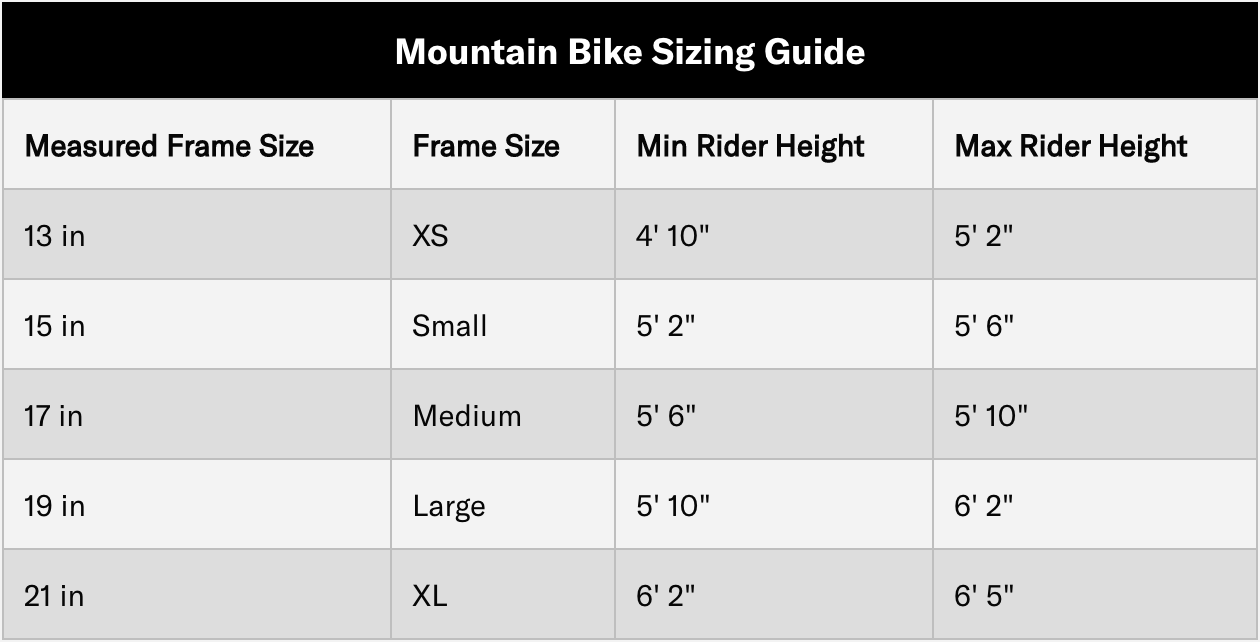
2. How much should I spend on a MTB?
Just like frame size, finding the right mountain bike to fit your budget is personal. Beginners might want to spend less to test the waters and see if they find a passion for mountain biking. In that case, we typically recommend bikes between $1,000 and $2,000. Although mountain bike technology changes fast, if you buy a used MTB produced in the last 3-5 years, you’ll get a better-quality bike and beat depreciation.
Intermediate mountain bikers would do well to spend a bit more, $2,000 to $3,000. This price range ensures that the suspension components are more capable, the drivetrain shifts with greater precision, and the overall bike weight is lighter.
Are you a dedicated racer or someone chasing maximum performance? Well, then the sky’s the limit. The harsh truth is that more expensive bikes nearly always provide better performance. It becomes a question of how much you can afford to get the marginal gains that come from spending $4,000, $5,000, or even more on a mountain bike.
[button]How much should you spend on a bike[/button]
3. Bike frame materials pros and cons
Usually, you have two choices in mountain bike frame materials: aluminum and carbon fiber. Steel and titanium mountain bikes are also options, but they’re less common and are more typical for hardtail frames with no rear suspension.
Now, how to choose between aluminum and carbon? Aluminum bikes are almost always more affordable, relative to carbon bikes of comparable spec. Carbon bikes are normally lighter weight, again comparing apples-to-apples in parts builds. Damaged aluminum bikes cannot be repaired, but most carbon frame damage can be repaired. That said, carbon is more prone to damage from impacts, like rock strikes, or awkwardly laying your bike down in a rock garden.
Riders who prioritize light weight and performance should go for a carbon bike, even if it means spending a bit more. Resale value will also be better with carbon. If you don’t care about weight, consider an aluminum bike to save a little money, which could perhaps be used for component upgrades.
Aluminum is also good for those who tend to abuse bikes with hard riding or who crash regularly. Steel and titanium hardtails are also great choices if you prioritize having a durable and long-lasting bike.
[button]Frame materials - Carbon vs. Aluminum[/button]
4. Mountain bike components guide
When we say components, we’re typically talking about the drivetrain parts — derailleur, cassette, chain, crank, and shifters — and brakes. Cockpit components and touch points like handlebars, stem, seatpost, and saddle may be worth considering when you buy a used mountain bike too.
The two most common drivetrain and brake manufacturers are Shimano and SRAM. Which brand you choose will largely come down to personal preference. Entry-level drivetrains will generally be cheaper, but less refined feeling and heavier. As you become more experienced and pickier, higher-end components may become more appealing.
Basic component hierarchy
|
Shimano |
SRAM |
|
|
Entry |
Deore |
SX |
|
Mid-Entry |
SLX |
NX |
|
Mid-Upper |
Deore XT |
GX |
|
Top |
XTR |
X01/XX1 |
Read more: Shimano vs. SRAM, Drivetrain tech
5. How much suspension travel do I need?
Full-suspension bikes use a shock and linkage to provide additional suspension in the rear. The main advantage of a full-suspension bike is that the rear suspension helps absorb impacts, gives riders a larger margin of error when going down a trail at high speed, and improves comfort on rough terrain. You can be less picky about line choice and don’t need to work as hard to remain smooth as you do on a hardtail. There is a wide range of travel options to choose from, depending on the style of riding you typically prefer.
If you prefer smooth trails, are considering trying some cross-country races, or simply want a lighter bike, a cross-country full-suspension bike with 100-120mm of travel will be best. The majority of recreational riders who ride a wide variety of terrain will want an all-around bike that has between 120 and 150mm of travel, vaguely termed a “trail bike.” And finally, if you want to ride steep, rough descents, an enduro bike with 150mm of travel or more will help you ride downhill with more confidence and speed.
Read more: Bike type, Overbiked vs. underbiked - how much mountain bike suspension travel do you need?, Fox vs. RockShox
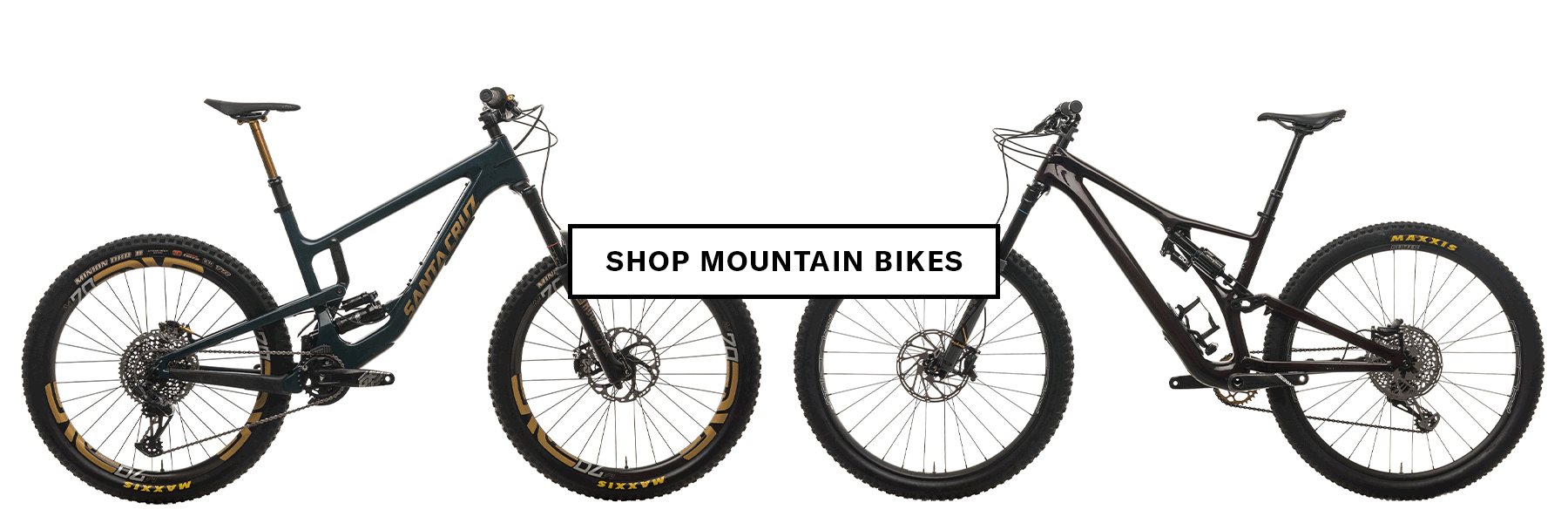
If you need help discerning a bike's category or which bike is for you, you can always contact our expert Ride Guides for assistance.
To learn more about mountain biking and other considerations when buying a bike, read on.
Other considerations:
Rider type
- What type of rider are you?
- How will you use your bike?
Here’s a handy exercise that helps define your riding style and narrow down your bike choices — imagine your dream riding scenario. This level of fantasy exists in some form within all of us, even if you've never ridden a bike before.
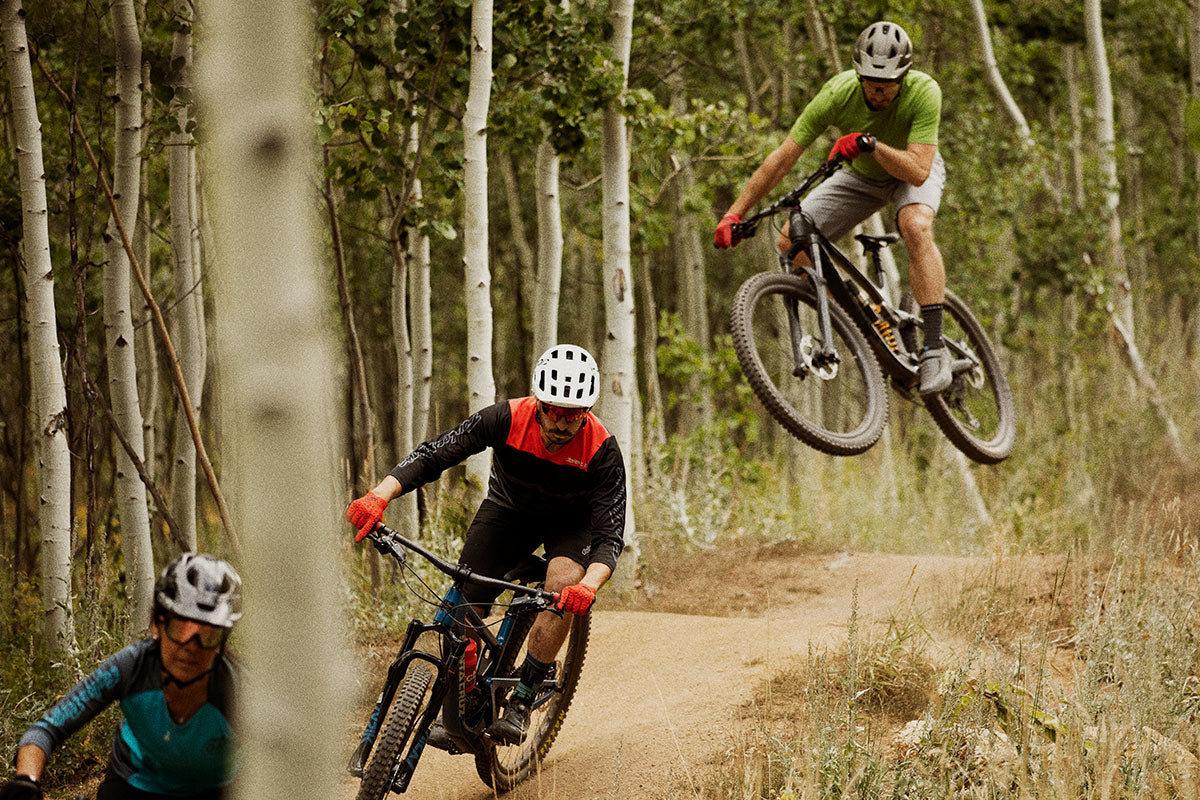
Is this how you imagine your riding? Or does it look a little different?
Do you see yourself ripping down trails at high speed, roosting corners, and boosting off jumps? Do you imagine yourself pedaling a featherweight bike easily uphill, going long distances, and summiting high mountains? Do you care more about the experience of descending or climbing?
Understanding how you idealize riding will ultimately be the compass that points you toward the right bike. The more downhill focused you are, the more "enduro" your bike should be. The more bike weight, climbing, and pedaling efficiency matter to you, the more cross-country or "XC" your bike should be.
Bike type
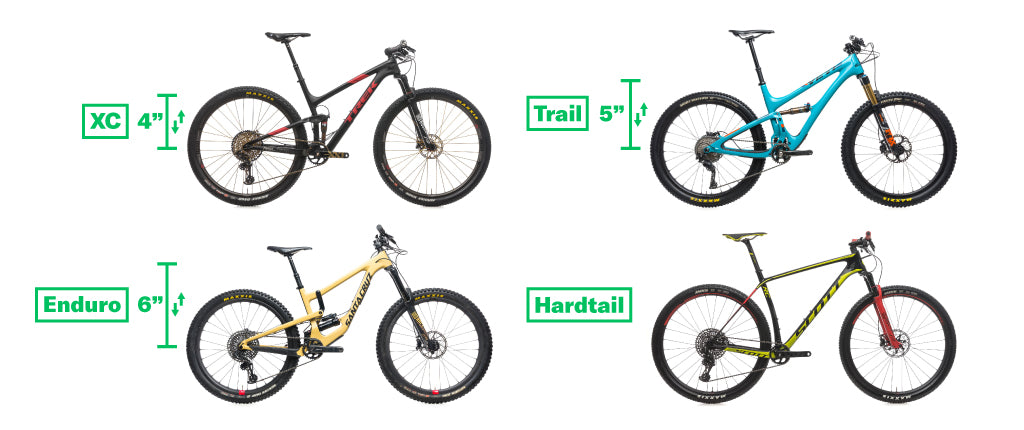
Full suspension
Full-suspension bikes use a shock and linkage to provide additional suspension in the rear. As stated earlier, the main advantage of a full-suspension bike is that the rear suspension helps absorb impacts, gives riders a larger margin of error when going down a trail at high speed, and improves comfort on rough terrain. You can be less picky about line choice and don’t need to work as hard to remain smooth as you do on a hardtail. There are a wide range of travel options to choose from, depending on the style of riding you typically prefer.
Suspension is a big concern for used mountain bikes. The fork and shock take a fair amount of abuse, and will generally require servicing to maintain good performance and feel. When looking at used mountain bikes, it’s a good idea to have money budgeted in case a bike needs a fork or shock service after the purchase. Fortunately, Certified Pre-Owned bikes have all suspension components inspected and serviced by our mechanics, so they’re always ready to perform right out of the box.
Choose a full suspension bike if you like to ride on rougher trails or need a bike that supports you more while descending. Full suspension bikes weigh slightly more than comparable hardtails, but many modern designs are still relatively efficient and give you added comfort on more technical terrain.
[newsletter]
XC: 100-120mm rear travel (~4")
XC (a.k.a. cross country) mountain bikes are designed to be faster, and more efficient for climbing, sprinting, and covering ground quickly. XC bikes are often lighter, easier to pedal, and have quick and responsive handling. They are good for riders focused on fitness, speed, and climbing, endurance and long distance rides, and XC racing.
[button]Shop XC bikes[/button]
Trail: 120-150mm rear travel (~5")
Trail mountain bikes are all-rounders, splitting the difference between XC and Enduro. In general, these bikes sit in the middle in terms of aggressiveness, travel, weight, and geometry. They are decent for a wide range of riding uphill and down, and are usually the best choice for the majority of riders looking to have fun and ride a large variety of trails.
[button]Shop trail bikes[/button]
Enduro: 150mm+ rear travel (~6")
Enduro mountain bikes are all about going downhill fast. Most enduro bikes will have more suspension travel, aggressive geometry geared more toward downhill stability than fast climbing, and heavier, more rugged componentry. They are good for riding steep and technical terrain, bike parks, and enduro racing.
[button]Shop enduro bikes[/button]
Hardtail
Hardtails have a suspension fork at the front of the bike with a rigid rear end. Because a hardtail doesn’t have a rear shock or the moving linkages required for rear suspension, it’s often cheaper and easier to maintain. Hardtails are very efficient when pedaling because there’s no rear suspension to bob or squat under power. Hardtails are a popular option for XC riders looking for the lightest and most efficient bike possible. XC and trail hardtails are the most common, but enduro hardtails do exist for those looking for a unique riding experience.
On rough and technical trails, they require more care when it comes to technique and line choice because the rear end is less forgiving of mistakes and big hits. Choose a hardtail if you’re looking for a bike that’s simpler and more reliable, or easier and cheaper to maintain, if you want an ultra-light XC racer, or if you want a bike that requires sharper riding technique and attention to improve your riding skills or make mellow trails more exciting. A hardtail can also be equipped with a rigid front fork instead of a suspension fork. A full rigid mountain bike can be a rough ride, but because there’s no suspension to sag or bob, rigid bikes are incredibly efficient and light. They are good for smooth trails or those willing to suffer. No moving suspension parts also mean they are cheaper to maintain.
[button]Shop hardtails[/button]
Wheel size
 In the beginning, 26” wheels were the standard for mountain bikes. Over the years though, new and different wheel sizes have taken over. The used mountain bike market is now filled with a plethora of size options, each with different characteristics, advantages, and disadvantages. Riders can select and experiment with wheels and tires that work best for them and their riding.
In the beginning, 26” wheels were the standard for mountain bikes. Over the years though, new and different wheel sizes have taken over. The used mountain bike market is now filled with a plethora of size options, each with different characteristics, advantages, and disadvantages. Riders can select and experiment with wheels and tires that work best for them and their riding.
Classic 26” wheels have mostly fallen by the wayside, but that means you’re often able to find used 26” bikes for a great price as long as you’re okay with compatibility concerns and reduced availability of new parts. Otherwise, it’s best to look for a used mountain bike utilizing one of the below options.
*Note: The majority of mountain bike wheels are now tubeless-ready. Non-tubeless options are becoming increasingly rare, even in the used marketplace. Any modern mountain bike should be tubeless at this point. Read more: The beginner's guide to tubeless tires.
27.5” Wheels
27.5” is the smallest common wheel size on modern bikes and it has replaced traditional 26” wheels as the smallest wheel size for enduro and downhill style bikes. It is good for those who want a playful bike that is easy to throw around, who ride more jumps and steep, technical tracks, or shorter riders who find 29” wheels to be too cumbersome.
[button]Shop 27.5”/27.5+ bikes[/button]
27.5+
27.5+ refers to wheels designed to run 27.5” tires between 2.8-3.0” wide. These are often called “plus” bikes. This larger tire provides more grip and a smoother ride thanks to greater air volume. Some bike models can switch between the 27.5+ and 29” wheel because they are a similar diameter. This is a good tire size for those looking for increased confidence and grip in loose conditions, or more comfort on longer rides.
[button]Shop 27.5”/27.5+ bikes[/button]
29”
Often called “29ers,” 29” wheels have greater “rollover” thanks to their larger diameter, making it easier for a bike to carry speed and momentum through rough terrain. They are the most popular option on modern XC bikes. It’s starting to become popular in enduro and downhill. It’s a good wheel size for XC racers, trail or enduro riders more interested in straight-line speed than maneuverability, or taller riders.
[button]Shop 29”/29+ bikes[/button]
29+
29+ refers to wheels designed to run 29” tires between 2.8-3.0” wide. This larger tire provides more grip and a smoother ride thanks to greater air volume. 29+ is the largest mountain bike diameter and has the most rollover of any wheel size at the expense of more weight. 29+ is popular for applications like bikepacking and is good for riders seeking greater comfort and traction. Smaller riders, however, may find them to be too large.
[button]Shop 29”/29+ bikes[/button]
Fat
Fat bikes are specialist bikes. To be considered a fat bike, wheels are 26” (sometimes 27.5”) and tires are generally between 3.8-5.0” wide. This ultra-wide rubber allows fat bikes to ride with some amount of “float,” meaning the tire doesn’t sink into the trail surface. This makes fat bikes the ideal choice for riding in unique conditions like snow and deep sand. The wider the tire, the more float it will have.
[button]Shop Fat Bikes[/button]
Drivetrain tech
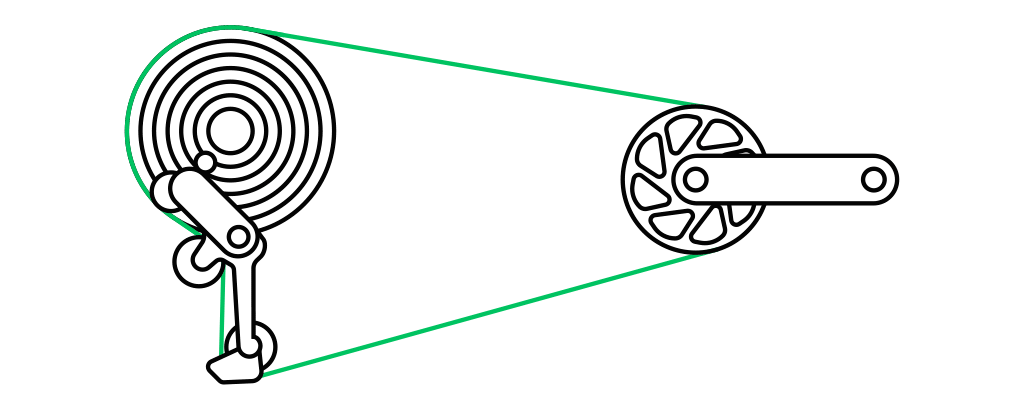 Drivetrains with a single front chainring are known as 1x (pronounced “one by”). 1x drivetrains are the most common option for modern mountain bikes because of their increased simplicity and reliability.
Drivetrains with a single front chainring are known as 1x (pronounced “one by”). 1x drivetrains are the most common option for modern mountain bikes because of their increased simplicity and reliability.
1x drivetrains utilize a chainring with a “narrow-wide” tooth profile which helps prevent the chain from falling off the chainring in rough and bouncy terrain as well as a clutched rear derailleur which helps chain retention by maintaining constant tension on the chain.
Shimano is currently the only manufacturer still offering a 2x (“two by”) drivetrain but these are getting rarer.
Singles speed drivetrains are another option, most commonly seen on hardtails. They are simple, inexpensive, and require very little maintenance. But know that you'll need some solid fitness if you want to ride trails with sustained or steep climbing.
With each generation, drivetrain manufacturers have been able to add cogs on the cassette to increase drivetrain speeds. The newest drivetrains from Shimano and SRAM have 12 speeds. The advantage of more speeds is that they allow for a wider gear range. Older 10 and 11-speed drivetrains work great and will cost less, at the expense of the large gear range.
If you want the latest and greatest tech, Shimano and SRAM also offer electronic drivetrains. Shimano Di2 and SRAM Eagle AXS drivetrains use batteries and motors to shift and represent the future of drivetrain technology.
Read more: Do you need electronic shifting?
Dropper Posts
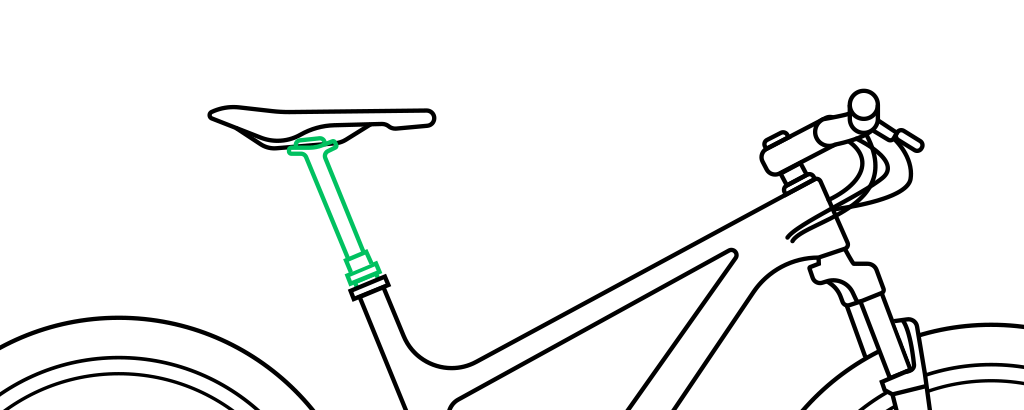 One of the greatest recent innovations to benefit mountain bike riders is the dropper post. A dropper is a hydraulic or spring-actuated seatpost that is height adjustable. These posts are usually controlled by a remote at the handlebar which allows a rider to instantaneously lower their saddle.
One of the greatest recent innovations to benefit mountain bike riders is the dropper post. A dropper is a hydraulic or spring-actuated seatpost that is height adjustable. These posts are usually controlled by a remote at the handlebar which allows a rider to instantaneously lower their saddle.
For optimal pedaling, you need proper leg extension to generate power and be efficient. A saddle positioned for optimal pedaling, however, is generally too high for most riders to descend comfortably. A lowered saddle is out of the way, allowing you to easily maneuver the bike around beneath you when cornering or descending on steep and technical terrain.
Like suspension, dropper posts on mountain bikes take a lot of abuse. Used droppers and even some new ones often have a poor reputation for reliability. If any sag, stiction, leakage, or other issues are present, then a dropper will need to be serviced or replaced. It's often expected and not a dealbreaker when buy a used mountain bike, as long as you have the money budgeted. Like suspension, The Pro's Closet inspects and services dropper posts on all Pre-Owned and Certified Pre-Owned mountain bikes, so there's just one less thing to worry about.
Some riders may find that they don’t need a dropper post. Either their local trails aren’t technical enough to justify its use, or they are concerned about the weight a dropper adds over a conventional seatpost. This is the reason many XC riders don’t use a dropper and XC bikes don’t come with one installed.
It’s ultimately up to each rider to decide if a dropper is necessary or not, but it is a feature that is worth considering when looking at a new bike. They are great for new riders because they allow them to descend with more confidence and safety. A dropper can be added or removed in the future.
[button]Shop dropper posts[/button]
Hopefully, this guide has helped you learn a thing or two about mountain bikes and have a good idea of the type of bike you want for your riding. Remember, if you ever need help, you can always contact our expert Ride Guides for assistance!
[button]Shop mountain bikes[/button]























